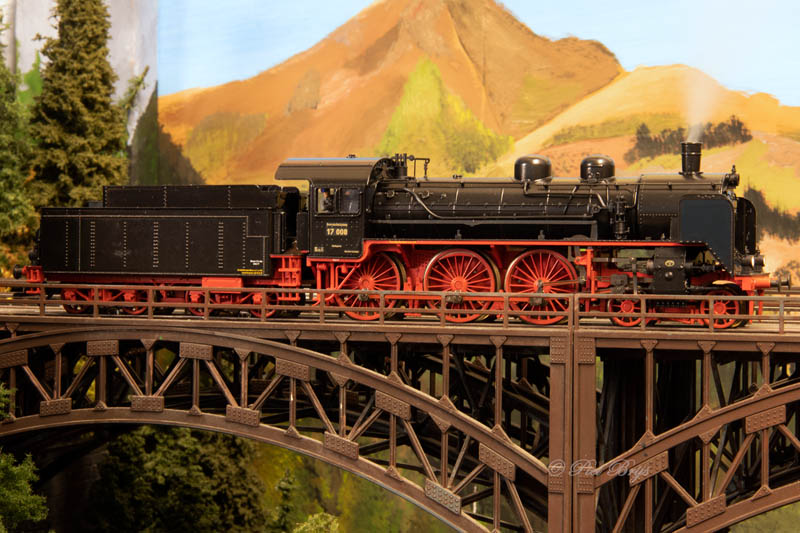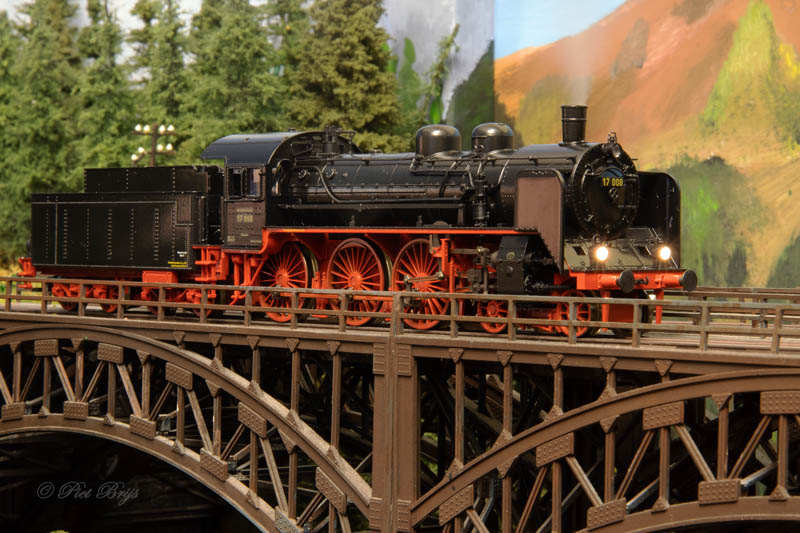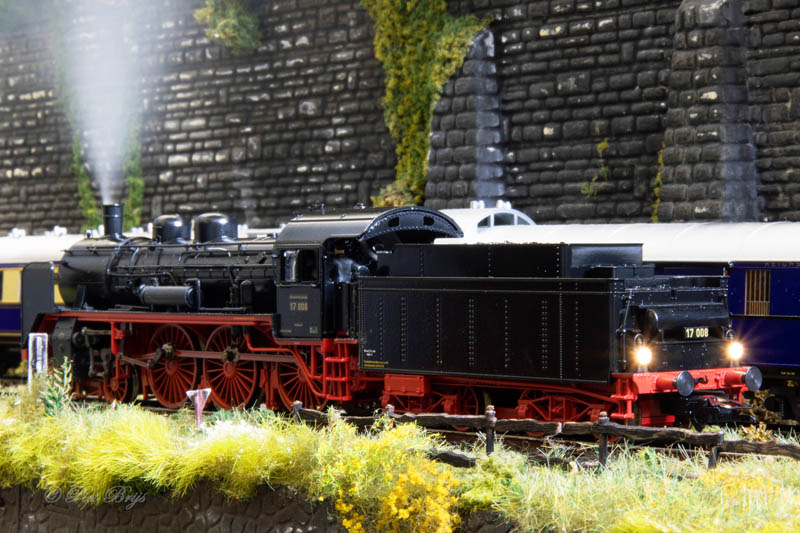DRG 17 008
|
|
Next: BR 17
Class DRG 17 008 Steam Locomotive
Between 1912 and 1914, BMAG, Hanomag, and Vulcan delivered 190 units in the first version. On the first units, the steam dome was initially located on the front boiler seam, the round sand dome behind it. They quickly changed places. While the first S 10 locomotives were initially coupled to the P 8 tender, the type 2‘2‘T21,5 (5 metric tons of coal), this was replaced as early as 1911 by the type 2‘2‘T31,5, which carried 7 metric tons of coal and 31.5 cubic meters / 8,321.42 gallons of water. This allowed the S 10 to have a range of about 300 kilometers / 188 miles without having to replenish water and coal. Service With just half of the total roster assigned to base stations, the railroad districts of Erfurt (47 units) and Münster (49 units) developed into strongholds for the S 10 locomotives. The second half were spread upon delivery to the districts of Breslau (10 units), Kassel (10 units), Cologne (4 units), Elberfeld (13 units), Essen (17 units), Halle (11 units), Kattowitz (10 units), Magdeburg (4 units), Mainz (13 units), and Saarbrücken (14 units). The end of World War I signified a large bloodletting of these units, because in addition to the loss of territory mainly in the East a large number of the S 10 locomotives had to be surrendered to the victors. In the meantime, the German State Railways was founded in Germany (starting June of 1921: German State Railroad, starting August of 1924: German State Railroad Company – DRG). One of the large tasks then was to standardize the variety of different designation systems inherited from the provincial railroads. Starting September of 1925, the remaining 134 units of the S 10 were finally assigned new road numbers and from then on ran as road numbers 17 001-041 and 043-135. As early as 1926, the first five locomotives were retired and in 1927 another twelve units followed. Two more S 10 units were not caught up in this wave until 1930, and then it really began: 1931: 28 units, 1932: 25 units, 1933: 22 units, and 1934: 10 locomotives. The ranks of the remaining S 10 locomotives slowly continued to decrease in the next few years. In the process, several units occasionally found a livelihood as braking locomotives with Riggenbach resistance brakes at the Locomotive Test Facility (LVA) in Grunewald. On December 31, 1940, the roster still hosted road numbers 17 039, 097, 102, 107, and 120. After the end of World War II, there were probably no more S 10 locomotives running in Germany. In the West Zones, road numbers 17 039 and 102 were retired on September 20, 1948. In the area of the DR in the GDR (East Germany) road number 17 107 remained stored in the Berlin District and was disposed of on February 15, 1951. Road Number 17 008 Road number 17 008 can be viewed in the German Technology Museum in Berlin as the sole preserved unit of the class 17.0. Road number 17 008 was delivered on February 3, 1912 by BMAG (Berlin Mechanical Engineering, Inc., formerly Schwartzkopff) with builder number 4760 to the Breslau District as road number S 10 1008 Bsl. There this locomotive with nine other units hauled mostly express trains in the direction of Upper Silesia.
Yet it was saved from being scrapped because the Brandenburg West maintenance facility restored it as a showpiece. In the process, its left side was cut away to demonstrate better the working of a steam locomotive. Eventually, it was given a place of honor on March 11 of the anniversary year of 1935 (100 Years of German Railroading) in the Berlin Transportation and Engineering Museum in the former Berlin-Hamburg Line Station, even on electrically driven rollers. After World War II, the museum was not open to the public for a long time due to the special status of railroading in West Berlin. It was not until 1984 with the takeover of the S-Bahn by the West Berlin Senate that ownership of the shutdown museum was acquired by the West. Sometime later, road number 17 008 was woken from its "Sleeping Beauty sleep" and transported on a depressed floor semi rig to the Neukölln Station and then moved on its own wheels across the Ringbahn or Ring Line to the Anhalt Freight Station.
Since October of 1987, it has enriched the German Technology Museum (until 1996 the Museum for Transportation and Technology) on the grounds of the former maintenance facility for the Berlin Anhalt Station, also here ready for demonstration on rollers.
Model
The locomotive has an mfx+ digital decoder and extensive sound functions. It also has high-efficiency propulsion with a flywheel, in the boiler. 3 axles powered. Traction tires. The locomotive and coal tender are constructed mostly of metal. A smoke unit is built into the locomotive. The dual headlights change over with the direction of travel. They and the smoke unit will work in conventional operation and can be controlled digitally. The cab lighting, firebox flickering, and oncoming train light are each digitally controlled separately. Maintenance-free, warm white and red LEDs are used for the lighting. There is a close coupling with a guide mechanism between the locomotive and tender. There is a close coupler with a guide mechanism and an NEM pocket on the rear of the tender. The minimum radius for operation is 360 mm. . Protective piston rod sleeves are included. Figures of an engineer and a fireman are included for installation in the cab. A booklet gives information about the history of the locomotive. Length over the buffers approximately 24.0.
Fifth and last locomotive in the 5-part series of museum locomotives..
Article number: 37197
Source Märklin catalogue




